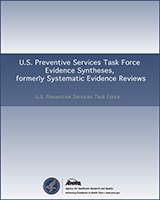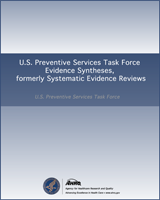NCBI Bookshelf. A service of the National Library of Medicine, National Institutes of Health.
This publication is provided for historical reference only and the information may be out of date.
Structured Abstract
Purpose:
To systematically review evidence on the benefits and harms of interventions provided in or referable from primary care to prevent child maltreatment for the U.S. Preventive Services Task Force (USPSTF).
Data Sources:
MEDLINE®, the Cochrane Library, EMBASE, and trial registries, through December 18, 2017; reference lists of retrieved articles; outside experts; reviewers; and surveillance of literature through July 17, 2018
Study Selection:
Two investigators independently selected studies using a priori criteria. Eligible trials (1) enrolled children (from birth through age 18 years with no known exposure to maltreatment and no signs or symptoms of current or past maltreatment) or their caregivers; (2) evaluated interventions feasible in a primary care setting or that could result from a referral by a primary care provider; and (3) reported abuse or neglect outcomes, or proxies for abuse or neglect (injury, visits to the emergency department, hospitalization).
Data Extraction:
One investigator extracted data and a second checked accuracy. Two reviewers independently rated quality for included studies using predefined criteria.
Data Synthesis:
Twenty-two trials provided evidence on benefits. We found no evidence of differences in reports to child protective services within 1 year of intervention completion (pooled odds ratio [OR], 0.94, 95% CI, 0.72 to 1.23; 10.6% vs. 11.9%; 10 studies, 2444 participants) or removal of the child from the home within 1 to 3 years of followup (pooled (OR: 1.09,95% CI, 0.16 to 7.28; 3.51% vs. 3.71%; 4 studies, 609 participants). Owing to heterogeneity of outcome measures, we could not pool other results, but the evidence either demonstrates no benefit or was inconclusive for abuse, neglect, or their sequelae. The evidence suggested no benefit for emergency department visits in the short-term (<2 years), hospitalizations, child development, school performance, and prevention of death. The evidence was inconclusive for long-term outcomes for reports to child protective services and emergency department visits (≥2 years) because results were inconsistent and imprecise. The evidence was also inconclusive for injuries, failure to thrive, failure to immunize, internalizing and externalizing behavior symptoms, school attendance, and other measures of abuse or neglect because of the limited number of trials reporting on each outcome and imprecise results. We found no results on harms.
Limitations:
The scope of this review limits conclusions to children who have not experienced maltreatment and to primary-care relevant interventions. Other limitations include the heterogeneity of the interventions and outcome measures and the lack of information on harms.
Conclusions:
Overall, the evidence on interventions provided in or referable from primary care to prevent child maltreatment does not consistently demonstrate benefit. We found no evidence on possible harms of these interventions. New studies that address a comprehensive array of risk factors and evaluate outcomes over the long term may help identify effective, generalizable, and acceptable interventions.
Contents
Suggested citation:
Viswanathan M, Fraser JG, Pan H, Morgenlander M, McKeeman JL, Forman-Hoffman VL, Hart LC, Zolotor AJ, Lohr KN, Patel SV, Jonas DE. Primary Care Interventions to Prevent Child Maltreatment: An Evidence Review for the U.S. Preventive Services Task Force. Evidence Synthesis No. 170. AHRQ Publication No. 18-05241-EF-1. Rockville, MD: Agency for Healthcare Research and Quality; 2018.
This report is based on research conducted by the RTI International–University of North Carolina Evidence-based Practice Center (EPC) under contract to the Agency for Healthcare Research and Quality (AHRQ), Rockville, MD (Contract No. HHSA-290-2015-00015-I, Task Order No. 5). The findings and conclusions in this document are those of the authors, who are responsible for its contents, and do not necessarily represent the views of AHRQ. Therefore, no statement in this report should be construed as an official position of AHRQ or of the U.S. Department of Health and Human Services.
The information in this report is intended to help health care decisionmakers—patients and clinicians, health system leaders, and policymakers, among others—make well-informed decisions and thereby improve the quality of health care services. This report is not intended to be a substitute for the application of clinical judgment. Anyone who makes decisions concerning the provision of clinical care should consider this report in the same way as any medical reference and in conjunction with all other pertinent information, i.e., in the context of available resources and circumstances presented by individual patients.
This report may be used, in whole or in part, as the basis for development of clinical practice guidelines and other quality enhancement tools, or as a basis for reimbursement and coverage policies. AHRQ or U.S. Department of Health and Human Services endorsement of such derivative products may not be stated or implied.
None of the investigators has any affiliations or financial involvement that conflicts with the material presented in this report.
- Review Primary Care Interventions to Prevent Child Maltreatment: An Evidence Review for the U.S. Preventive Services Task Force[ 2024]Review Primary Care Interventions to Prevent Child Maltreatment: An Evidence Review for the U.S. Preventive Services Task ForceViswanathan M, Rains C, Hart LC, Doran E, Sathe N, Hudson K, Ali R, Jonas DE, Chou R, Zolotor AJ. 2024 Mar
- Primary Care Interventions to Prevent Child Maltreatment: Updated Evidence Report and Systematic Review for the US Preventive Services Task Force.[JAMA. 2018]Primary Care Interventions to Prevent Child Maltreatment: Updated Evidence Report and Systematic Review for the US Preventive Services Task Force.Viswanathan M, Fraser JG, Pan H, Morgenlander M, McKeeman JL, Forman-Hoffman VL, Hart LC, Zolotor AJ, Lohr KN, Patel S, et al. JAMA. 2018 Nov 27; 320(20):2129-2140.
- Primary Care Interventions to Prevent Child Maltreatment: Evidence Report and Systematic Review for the US Preventive Services Task Force.[JAMA. 2024]Primary Care Interventions to Prevent Child Maltreatment: Evidence Report and Systematic Review for the US Preventive Services Task Force.Viswanathan M, Rains C, Hart LC, Doran E, Sathe N, Hudson K, Ali R, Jonas DE, Chou R, Zolotor AJ. JAMA. 2024 Mar 19; 331(11):959-971.
- Review Screening for Intimate Partner Violence, Elder Abuse, and Abuse of Vulnerable Adults: An Evidence Review for the U.S. Preventive Services Task Force[ 2018]Review Screening for Intimate Partner Violence, Elder Abuse, and Abuse of Vulnerable Adults: An Evidence Review for the U.S. Preventive Services Task ForceFeltner C, Wallace I, Berkman N, Kistler C, Middleton JC, Barclay C, Higginbotham L, Green JT, Jonas DE. 2018 Oct
- Review Screening and Interventions for Childhood Overweight[ 2005]Review Screening and Interventions for Childhood OverweightWhitlock EP, Williams SB, Gold R, Smith P, Shipman S. 2005 Jul
- Primary Care Interventions to Prevent Child Maltreatment: An Evidence Review for...Primary Care Interventions to Prevent Child Maltreatment: An Evidence Review for the U.S. Preventive Services Task Force
Your browsing activity is empty.
Activity recording is turned off.
See more...

